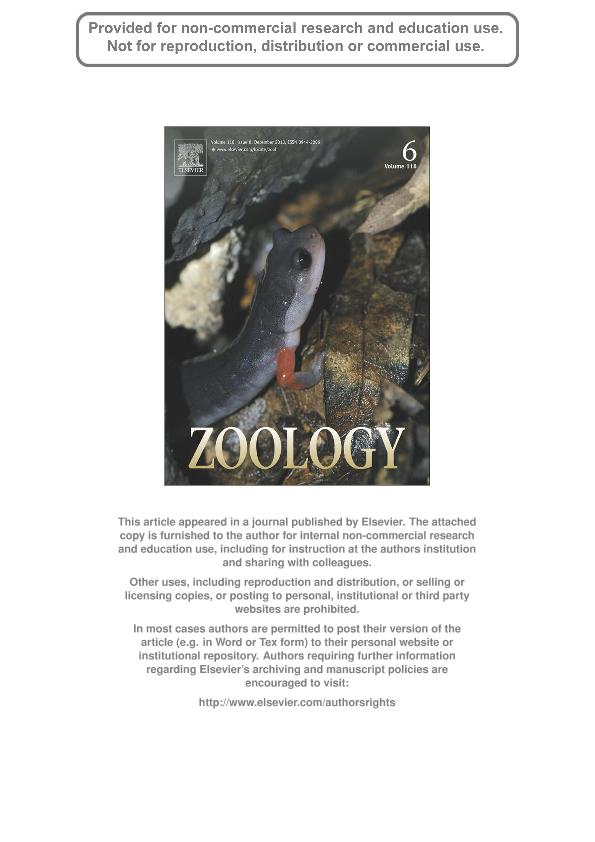Mostrar el registro sencillo del ítem
dc.contributor.author
Flores, David Alfredo

dc.contributor.author
Abdala, Fernando
dc.contributor.author
Giannini, Norberto Pedro

dc.date.available
2016-12-01T18:00:30Z
dc.date.issued
2013-10-08
dc.identifier.citation
Flores, David Alfredo; Abdala, Fernando; Giannini, Norberto Pedro; Post-weaning cranial ontogeny in two bandicoots (Mammalia, Peramelomorphia, Peramelidae) and comparison with carnivorous marsupials; Elsevier; Zoology; 116; 8-10-2013; 372-384
dc.identifier.issn
0944-2006
dc.identifier.uri
http://hdl.handle.net/11336/8591
dc.description.abstract
The ontogeny of the skull has been studied in several marsupial groups such as didelphids, microbiotheriids, and dasyurids. Here, we describe and compare the post-weaning ontogeny of the skull in two species of bandicoots, Echymipera kalubu (Echymiperinae) and Isoodon macrourus (Peramelinae), analyzing specific allometric trends in both groups, describing common (and specific) patterns, and discussing them on functional and phylogenetic grounds. Growth patterns were analyzed both qualitatively and quantitatively, including bivariate and multivariate analyses of allometry. We also evaluated character transformation and phylogenetic signals of the allometric patterns in several groups of marsupials and some placentals. We identified morphological changes between juvenile and adult stages in both species of peramelids, many related to the development of the trophic apparatus. Notable differences were detected in the patterns of growth, suggesting divergences in ontogenetic trajectories between both species. Both bivariate and multivariate methods indicate that positive allometries in E. kalubu apply to longitudinal dimensions, whereas in I. macrourus, positive allometries are restricted to vertical dimensions of the skull. The comparison of the allometric trends of two bandicoots with previously studied taxa reveals that although peramelids exhibit a particularly short gestation period and divergent morphology compared to other marsupials, their pattern does not show any particular trend. Some allometric trends seem to be highly conserved among the species studied, showing weak phylogenetic signal. Marsupials in general do not show particular patterns of post-weaning skull growth compared with placentals.
dc.format
application/pdf
dc.language.iso
eng
dc.publisher
Elsevier

dc.rights
info:eu-repo/semantics/openAccess
dc.rights.uri
https://creativecommons.org/licenses/by-nc-sa/2.5/ar/
dc.subject
Australidelphians
dc.subject
Marsupials
dc.subject
Post-Weaning Ontogeny
dc.subject
Skull Morphology
dc.subject.classification
Zoología, Ornitología, Entomología, Etología

dc.subject.classification
Ciencias Biológicas

dc.subject.classification
CIENCIAS NATURALES Y EXACTAS

dc.title
Post-weaning cranial ontogeny in two bandicoots (Mammalia, Peramelomorphia, Peramelidae) and comparison with carnivorous marsupials
dc.type
info:eu-repo/semantics/article
dc.type
info:ar-repo/semantics/artículo
dc.type
info:eu-repo/semantics/publishedVersion
dc.date.updated
2016-11-22T21:11:12Z
dc.journal.volume
116
dc.journal.pagination
372-384
dc.journal.pais
Países Bajos

dc.journal.ciudad
Amsterdam
dc.description.fil
Fil: Flores, David Alfredo. Consejo Nacional de Investigaciones Científicas y Técnicas. Oficina de Coordinación Administrativa Parque Centenario. Museo Argentino de Ciencias Naturales; Argentina
dc.description.fil
Fil: Abdala, Fernando. University of the Witwaterstrand; Sudáfrica
dc.description.fil
Fil: Giannini, Norberto Pedro. Universidad Nacional de Tucumán, Catedra de Biogeografia; Argentina
dc.journal.title
Zoology

dc.relation.alternativeid
info:eu-repo/semantics/altIdentifier/doi/http://dx.doi.org/10.1016/j.zool.2013.07.003
dc.relation.alternativeid
info:eu-repo/semantics/altIdentifier/url/http://www.sciencedirect.com/science/article/pii/S0944200613000822
Archivos asociados
